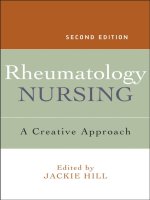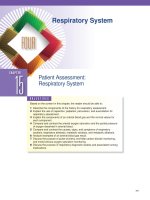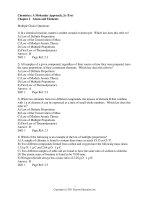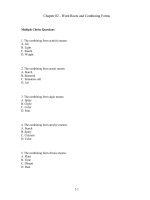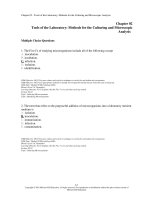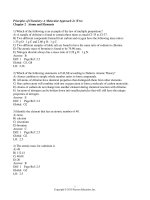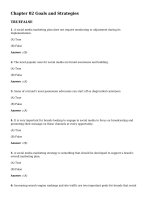Rheumatology Nursing A Creative Approach 2nd edition doc
Bạn đang xem bản rút gọn của tài liệu. Xem và tải ngay bản đầy đủ của tài liệu tại đây (6.47 MB, 562 trang )
Rheumatology
Nursing
A Creative Approach 2nd edition
Edited by
JACKIE HILL
Rheumatology Nursing
Rheumatology
Nursing
A Creative Approach 2nd edition
Edited by
JACKIE HILL
Copyright © 2006 Whurr Publishers Limited (a subsidiary of John Wiley & Sons Ltd)
The Atrium, Southern Gate, Chichester,
West Sussex PO19 8SQ, England
Telephone (+44) 1243 779777
Email (for orders and customer service enquiries):
Visit our Home Page on www.wiley.com
All Rights Reserved. No part of this publication may be reproduced, stored in a retrieval system
or transmitted in any form or by any means, electronic, mechanical, photocopying, recording,
scanning or otherwise, except under the terms of the Copyright, Designs and Patents Act 1988
or under the terms of a licence issued by the Copyright Licensing Agency Ltd, 90 Tottenham
Court Road, London W1T 4LP, UK, without the permission in writing of the Publisher. Requests
to the Publisher should be addressed to the Permissions Department, John Wiley & Sons Ltd,
The Atrium, Southern Gate, Chichester, West Sussex PO19 8SQ, England, or emailed to
, or faxed to (+44) 1243 770620.
Designations used by companies to distinguish their products are often claimed as trademarks.
All brand names and product names used in this book are trade names, service marks, trade-
marks or registered trademarks of their respective owners. The Publisher is not associated with
any product or vendor mentioned in this book.
This publication is designed to provide accurate and authoritative information in regard to the
subject matter covered. It is sold on the understanding that the Publisher is not engaged in
rendering professional services. If professional advice or other expert assistance is required,
the services of a competent professional should be sought.
Other Wiley Editorial Offi ces
John Wiley & Sons Inc., 111 River Street, Hoboken, NJ 07030, USA
Jossey-Bass, 989 Market Street, San Francisco, CA 94103-1741, USA
Wiley-VCH Verlag GmbH, Boschstr. 12, D-69469 Weinheim, Germany
John Wiley & Sons Australia Ltd, 42 McDougall Street, Milton, Queensland 4064, Australia
John Wiley & Sons (Asia) Pte Ltd, 2 Clementi Loop #02-01, Jin Xing Distripark, Singapore
129809
John Wiley & Sons Canada Ltd, 22 Worcester Road, Etobicoke, Ontario, Canada M9W 1L1
Wiley also publishes its books in a variety of electronic formats. Some content that appears in
print may not be available in electronic books.
Library of Congress Cataloging-in-Publication Data
Rheumatology nursing : a creative approach / edited by Jackie Hill. – 2nd ed.
p. ; cm.
Includes bibliographical references and index.
ISBN-13: 978-0-470-01961-0
ISBN-10: 0-470-01961-1
1. Musculoskeletal system–Diseases–Nursing. 2. Arthritis–Nursing.
3. Rheumatism–Nursing. I. Hill, Jacqueline, 1946–
[DNLM: 1. Rheumatic Diseases–nursing. 2. Orthopedic Nursing–methods.
WY 157.6 R472 2006]
RC925.5.R48 2006
616.7′23 – dc22
2005029943
British Library Cataloguing in Publication Data
A catalogue record for this book is available from the British Library
ISBN-13 978-0-470-01961-0
ISBN-10 0-470-01961-1
Type set by SN P Best-set Typesetter Ltd., Hong Kong
Printed and bound in Great Britain by TJ International Ltd, Padstow, Cornwall
This book is printed on acid-free paper responsibly manufactured from sustainable forestry in
which at least two trees are planted for each one used for paper production.
Contents
SECTION 1 SETTING THE SCENE
This section provides an overview of the musculoskeletal system and the
immune system and describes how rheumatic conditions affect them. A
chapter is also devoted to the different investigations that are used to diagnose
and assess the patient. The central role of the nurse caring for the rheumatic
patient is discussed and the benefi ts of adopting a therapeutic rather than an
exclusively supportive framework is advocated. The expanding role of the
nurse within the speciality is explored, including the role of the consultant
nurse, nurse-led clinics and academic nursing roles.
1 The Principles, Practice and Evolution of Rheumatology
Nursing 3
Sarah Ryan and Jackie Hill
2 The Musculoskeletal System and the Rheumatic Diseases 25
Valerie Arthur and Jackie Hill
3 The Immune System and Rheumatic Disease 93
Susan Oliver
4 Biochemical, Haematological and Clinical Assessments in the
Rheumatic Diseases 123
Jackie Hill
SECTION 2 ADDRESSING THE PATIENT’S PROBLEMS
People who have rheumatic diseases encounter many physical, psychological
and social problems. This section will highlight the problems and this will
enable the nurse to address them systematically using effective methods of
intervention. A model based on patient problems is used as a framework to
provide a logical and structured approach to care.
5 The Psychological Aspects of Rheumatic Disease 151
Sarah Ryan
6 The Effects of Rheumatic Disease on Body Image and
Sexuality 173
Jackie Hill
7 The Social Implications of Rheumatic Disease 193
Sarah Ryan
8 Pain and Stiffness 217
Jackie Hill
9 Fatigue and Sleep 245
Christine White
10 The Skin and Nutrition 271
Naomi Reay, Sally Smith and Jill Byrne
SECTION 3 THERAPEUTIC INTERVENTIONS
The multifaceted nature of rheumatic diseases requires a combination of
therapies. In addition to conventional treatments such as drug therapy and
surgery, this section includes complementary therapeutic interventions such
as aromatherapy and acupuncture. Continuing the theme of empowering and
working in partnership with the patient, this chapter is underpinned by a
chapter on patient education.
11 Multidisciplinary Team Care of the Rheumatic Patient 311
Pauline Fitzgerald
12 Medications in the Rheumatic Diseases 337
Jo White and Domini Bryer
13 Complementary Interventions 373
Anne Cawthorn and Peter Mackereth
14 Surgical Interventions 401
Maureen Cox
15 Patient Education 435
Jackie Hill
SECTION 4 PRIMARY AND PAEDIATRIC CARE
A person with a rheumatic disease is often cared for in both the primary and
secondary sector. This ‘shared care’ makes an important contribution to the
patient’s well-being but requires adequate support mechanisms to function
effi ciently. The factors necessary to implement effective shared-care schemes
vi
CONTENTS
CONTENTS vii
are discussed in detail. The fi nal chapter concerns children and young people.
Although children with rheumatic diseases share many of the problems faced
by adults, they and their families also confront many discrete additional
problems. The chapter on paediatric care provides a description of the clas-
sifi cation of Juvenile Idiopathic Arthritis and its treatments, and describes
the educational and psychological needs of this vulnerable group.
16 Seamless Primary and Secondary Care 461
Mandy Edwards
17 Paediatric Care 483
Gill Jackson
Index 519
About the Editor
Jackie Hill is an arc Senior Lecturer in Rheumatology Nursing and Co-
Director of the Academic and Clinical Unit for Musculoskeletal Nursing
(ACUMeN). She has worked in the fi eld of rheumatology for over 25 years
as both a clinician and an academic and has gained an international reputa-
tion as a leader in the development of the specialty. She has undertaken some
of the seminal research into outcomes from rheumatology nursing care and
published widely on the subject. She is an Associate Editor of the journal
Musculoskeletal Care and holds the offi ce of President of British Health
Professionals Rheumatology (BHPR).
Contributors
Mrs Valerie Arthur M Phil, RGN
Clinical Nurse Specialist in Rheumatology (retired)
University Hospital
Birmingham, UK
Miss Domini Bryer RGN, Dip N, BSc (Hons), MA
Biologics Nurse Specialist in Rheumatology
Regional Rheumatology Centre
Day Case Unit/Ward 8
Chapel Allerton Hospital
Leeds, West Yorkshire, UK
Mrs Jill Byrne RGN, SCM, MSc
Director of Nursing and Midwifery
Stockport NHS Foundation Trust
Stepping Hill Hospital
Stockport, Cheshire, UK
Mrs Anne Cawthorn, MSc, BSc, RGN, Dip N, Dip Aromatherapy
Lecturer in Nursing/Psychotherapy Practitioner
School of Nursing
University of Manchester
Christie Hospital
Manchester, UK
Mrs Maureen Cox, RGN, MSc, Dip N, SCM, ONC
Clinical Nurse Specialist in Rheumatology
Nuffi eld Orthopaedic Centre
Headington
Oxford, UK
Mrs Mandy Edwards SRN, BSc (Hons), FETC
Specialist Practitioner, Practise Nurse
Bilbrook Medical Centre
Bilbrook
Staffordshire, UK
CONTRIBUTORS xi
Mrs Pauline Fitzgerald RGN, BSc (Hons), Nursing Studies
Senior Sister
Ward 2, Rheumatology
Chapel Allerton Hospital
Leeds, West Yorkshire, UK
Jackie Hill PhD, MPhil, RN, FRCN
arc Senior Lecturer in Rheumatology Nursing
and Co-Director of the Academic and Clinical Unit for Musculoskeletal
Nursing (ACUMeN)
Academic Unit of Musculoskeletal Diseases
University of Leeds
Chapel Allerton Hospital
Leeds, West Yorkshire, UK
Mrs Gill Jackson, RGN, RSCN
Children’s Rheumatology Nurse Specialist
A Floor, Clarendon Wing
Leeds General Infi rmary
Leeds, West Yorkshire, UK
Mr Peter Mackereth MA Cert Ed, RNT, RGN, Dip. Nursing
Clinical Lead & Lecturer Complementary Therapies
Christie Hospital NHS Trust & Salford University
Manchester, UK
Mrs Susan Oliver RGN, MSc
Independent Nurse Specialist Rheumatology
Litchdon Medical Centre, North Devon
and 10 Harley Street, London, UK
Mrs Naomi Reay RGN, RSCN, DN, SRCh, BSc (Hons), MA
Clinical Nurse Specialist Raynauds and Scleroderma
Department of Rheumatology and Rehabilitation
University of Leeds
Leeds, West Yorkshire, UK
Dr Sarah Ryan, RGN, PhD, MSc, BSc, FRCN
Nurse Consultant Rheumatology
Haywood Hospital
Stoke on Trent, Staffordshire, UK
xii CONTRIBUTORS
Mrs Sally Smith, RN (DiP HE) BSc (Hons)
Raynauds & Scleroderma Nurse Specialist
Rheumatology Department
Chapel Allerton Hospital
Leeds, West Yorkshire, UK
Mrs Christine White RGN
Rheumatology Nurse Specialist (retired)
Mid Yorkshire Hospital Trust
Wakefi eld
West Yorkshire, UK
Jo White, RGN, MA
Clinical Nurse Specialist in Rheumatology
Rheumatology Department
Leeds General Infi rmary
Leeds, West Yorkshire, UK
Acknowledgements
I would like to thank all the nurses and patients who have shared their knowl-
edge and experience with me over the years, but a few individuals need special
thanks.
Firstly, I would like to thank my fellow ‘scribes’ many of whom are renowned
experts in their chosen topics and all have been keen to share their
knowledge.
Anne Bassett deserves my thanks and a medal for her guidance and unbe-
lievable forbearance.
Helen Greenwood has spent many hours checking references and co-
ordinating changes, all well beyond the call of duty!
Finally, I have to give my love and thanks to my husband Geoff whose
unbelievable tolerance is something to behold and whose ‘household manage-
ment skills’ have improved no end whilst I was editing this second edition.
Preface
Musculoskeletal diseases are the most common causes of disability in devel-
oped countries throughout the world, and in the United Kingdom, a signifi -
cant rheumatic disease affects one in seven of the population. They also affect
people from all walks of life and of all age groups including babies and the
very elderly. Rheumatic diseases are so common that it is inevitable that every
nurse will at some time provide care for a rheumatic patient. It is therefore
essential that they have some knowledge of rheumatology nursing. Histori-
cally this knowledge has been diffi cult to acquire as there is a paucity of
textbooks specifi cally about rheumatology nursing, and therefore the aim of
this book is to fi ll this gap.
The essence of rheumatology nursing is the ‘Three E’s’; educating, em-
powering and enabling our patients. This requires the nurse to work in part-
nership with the patient and their carers and to adopt a holistic approach to
care. This approach is acknowledged in each chapter by the seventeen expe-
rienced senior nurses who have written this edition.
The book is intended primarily for nurses working at post basic level, but
it will also be a useful resource for pre-registered nurses. It is also intended
to accommodate continuing nurse education and this is emphasised by the
inclusion of aims and intended learning outcomes at the beginning of each
chapter, and action points for practice at the end.
The book aims to enhance all aspects of nursing practice and will be par-
ticularly helpful to nurses working in the fi elds of rheumatology, orthopaedic
surgery and in general practice. It will also prove useful to nurses caring for
patients on geriatric or general medical and surgical wards as rheumatic
disease is often a secondary diagnosis. This new edition includes a chapter
on the care of children and juveniles with Juvenile Idiopathic Arthritis. This
specialist subject was omitted from the fi rst edition but it has been included
for completeness.
The book is in four sections. The fi rst sets the scene and comprises
four chapters. Chapter one discusses the underlying principles of rheuma-
tology nursing and focuses on the benefi ts of adopting a therapeutic rather
than a purely supportive approach to care delivery. The next two chapters
are devoted to the diseases, their diagnoses and their effect on the immune
system. Chapter four outlines the various biochemical, haematological,
cli nical and other assessments used to diagnose and assess the patient’s
outcome.
xvi PREFACE
The second section of the book comprises six chapters all of which address
the patient’s problems. The chapters include effective interventions that help
relieve symptoms such as pain and stiffness, fatigue and sleep disturbance
and the psychological and social effects. The effects of rheumatic diseases on
the skin are explored and also included is a discussion of the relationship
between skin integrity and nutrition and a summary of the effectiveness of
dietary supplementation on the rheumatic diseases. Pain, disability and
changes in body image can have a profound effect on both sexual function
and pregnancy and this is explored in detail. One chapter is devoted to the
role of the multidisciplinary team and the care they provide.
The third section of the book focuses on therapeutic interventions. The
chapter on medications includes up-to-date information on new developments
such as biologic therapies. Other chapters included are complementary thera-
pies and caring for the patient undergoing surgical interventions. Teaching
patients about their disease and its treatments is the foundation upon which
successful management programmes are built and no book on caring for the
rheumatology patient would be complete without a chapter on patient educa-
tion. Various approaches to patient teaching are discussed and methods of
assessing and writing educational material are described.
The fourth section focuses on primary care and paediatric care.
Rheumatology as a speciality has often been described as one of the Cin-
derella Services; it is not seen as a glamorous, emotive or technical branch of
nursing. However, to those of us who work in it and love it, nursing the patient
with a rheumatic disease is a truly stretching and satisfying experience.
Although essential, our nurturing nursing skills alone will not provide the
quality of service that our patients deserve. The aim of providing a high
quality rheumatology nursing service will be achieved only through great
depth and breadth of knowledge; this book represents one step on the road
to realising that aim.
I Setting the Scene
and Evolution of
Rheumatology Nursing
S. RYAN
Haywood Hospital, Staffordshire, UK
J. HILL
University of Leeds, West Yorkshire, UK
Rheumatology Nursing: A Creative Approach, 2nd edn. Edited by Jackie Hill.
Copyright 2006 by John Wiley & Sons, Ltd.
The aim of this chapter is to provide an understanding of the important con-
tribution that therapeutic nursing can make to a patient living with a chronic
rheumatological condition. After reading this chapter the reader should be
able to:
• describe the key elements of nursing and explain why they are important
to a patient with a rheumatological condition;
• discuss the skills and qualities required for the nurse to enter into a thera-
peutic relationship;
• describe the difference between supportive and therapeutic nursing and
provide examples to illustrate this;
• discuss the actual and potential barriers to therapeutic practice;
• outline the components of the nurse consultant role.
DEFINITIONS OF NURSING
The most widely known defi nition of nursing is that of Henderson (1966) who
states that ‘the unique function of the nurse is to assist the individual sick or
well in the performance of those activities contributing to health or its recov-
ery (or to a peaceful death) that he would perform unaided if he had the
necessary strength, will or knowledge, and to do this in such a way as to help
him gain independence as rapidly as possible’. Although this defi nition is not
new, it contains the elements relevant to today’s health care with its emphasis
on empowerment, rehabilitation, education and self-management.
4 RHEUMATOLOGY NURSING: A CREATIVE APPROACH
Health and illness are not static but dynamic entities, fl uctuating in response
to many internal and external infl uences. The role that the nurse assumes will
be governed by the patient’s perceived need at any particular time. Shaul
(1995) in a qualitative study, identifi ed four defi ned stages that patients
encountered as they adjusted to living with rheumatoid arthritis (RA). These
included:
• becoming aware (Symptoms became persistent and impacted work, the
family and mood.);
• seeking medical help;
• learning to live with it (Through experience, the individual develops dif-
ferent coping strategies that equate with their context.);
• mastery (The individual adapts and lives with the symptoms.).
CARING
Caring is one of the most important values of the nursing profession. Although
often referred to as a basic requirement, there is nothing basic about high
quality nursing care. The term ‘basic care’ has been used and interpreted
incorrectly to the detriment of the profession. Nursing requires a combination
of:
• knowledge
• understanding
• expertise.
Identifying and meeting the needs of patients who are unable to care fully for
themselves involves having regard for people as individuals and being con-
cerned about what happens to them (Malin and Teasdale, 1991). The process
of caring comprises elements of both action and emotion. However, in prac-
tice the action element frequently dominates, as the nurse concentrates on
the patient’s physical needs (May, 1991; Henderson, 1994). This can result in
a neglect of the emotional needs that have been shown to be the predominat-
ing factor infl uencing the experience of good or bad care as perceived by
patients (Smith, 1992).
An overemphasis on the physical manifestation of rheumatoid arthritis
(RA) such as synovitis of the small joints, without consideration of the effects
the condition has on the individual’s lifestyle, will not provide comprehensive
care and may well be harmful. RA can impact on the patient’s social activity
with over 50% of patients experiencing social isolation (Yelin and Callahan,
1995). If no one has explored the emotional impact of chronic illness with the
patient, they may fi nd themselves bewildered, and unsure of where to turn
PRINCIPLES, PRACTICE AND EVOLUTION 5
for help and advice. It is common for patients with a chronic condition to
experience a plethora of emotions including:
• shock
• anger
• grief
• depression.
It is essential that the nurse has the necessary support and education to
provide the emotional elements of care; otherwise care will not be holistic,
meaningful or relevant to the patient.
THE ELEMENTS OF NURSING
The key elements or functions of nursing can be seen in Table 1.1. The main
link between the elements is the nature of the relationship between the nurse
and the patient.
Once problems have been identifi ed, a plan of care will be formulated
which incorporates the patient’s identifi ed needs. Chronic conditions have a
global impact on the patient’s life; living with a rheumatological illness will
affect not only the individual but also their family and signifi cant others
(Ryan, 1996a). The social implications of rheumatological illness are dis-
cussed in Chapter 7.
As well as a sound knowledge base, the nurse will require the ability to
understand exactly what physical disability means to each individual (Powell,
1991). For instance, a mother with active infl ammation in her hands may be
prevented from lifting her child, causing feelings of guilt and anxiety. She
must be allowed to express her feelings and be given support and advice about
practical measures such as lying on the bed to cuddle her child. For others,
infl ammatory changes in the hands may affect their ability to work, causing
depression and poor self-esteem. Counselling will be required to support the
individual through this life crisis, but until the nurse is able to appreciate and
understand the impact of illness from the patient’s perspective, they will not
be able to offer care from a humanistic viewpoint.
Table 1.1 Nursing functions (Wilson-Barnett 1984)
• Understanding illness and treatment from the patient’s viewpoint
• Providing continuous psychological care during illness and critical events
• Helping people cope with illness or potential health problems
• Providing comfort
• Coordinating treatment and other events affecting the patient
6 RHEUMATOLOGY NURSING: A CREATIVE APPROACH
Essentially, nursing is a social activity. The nurse will need to possess good
communication skills and a level of understanding and knowledge about the
complex nature of rheumatological illness to be able to offer a complete care
package.
THE PHILOSOPHY OF NURSING
A philosophy of practice is essential. It should provide a clear outline of what
nurses perceive to be important and central to their practice. This ensures a
continuity of approach and can unify the team and ensure that care is prac-
tised from a shared understanding with an identifi ed purpose. If nurses
working within a clinical area do not share a common purpose, disunity and
fragmentation of care can occur. To be meaningful, the philosophy should be
derived from those working in both primary and secondary care. Each clinical
area will need to determine and develop the beliefs that shape present prac-
tice. A philosophy imposed by the wider organisation without the necessary
consultation will probably fail in its objective. A rheumatology philosophy of
care can be divided into four interlinked and complementary areas (Figure
1.1). Underpinning each area is the patient as the central focus of care
delivery.
BELIEFS RELATING TO HEALTH
Health is the state in which the individual has adapted to physical, psychologi-
cal and/or social imbalances and is able to cope with their arthritis in a posi-
tive and constructive manner. In the context of rheumatological conditions,
health does not mean the removal of all symptoms, as this would be an unre-
HEALTH ENVIRONMENT
NURSING INDIVIDUAL
Figure 1.1 The rheumatology philosophy of care.

